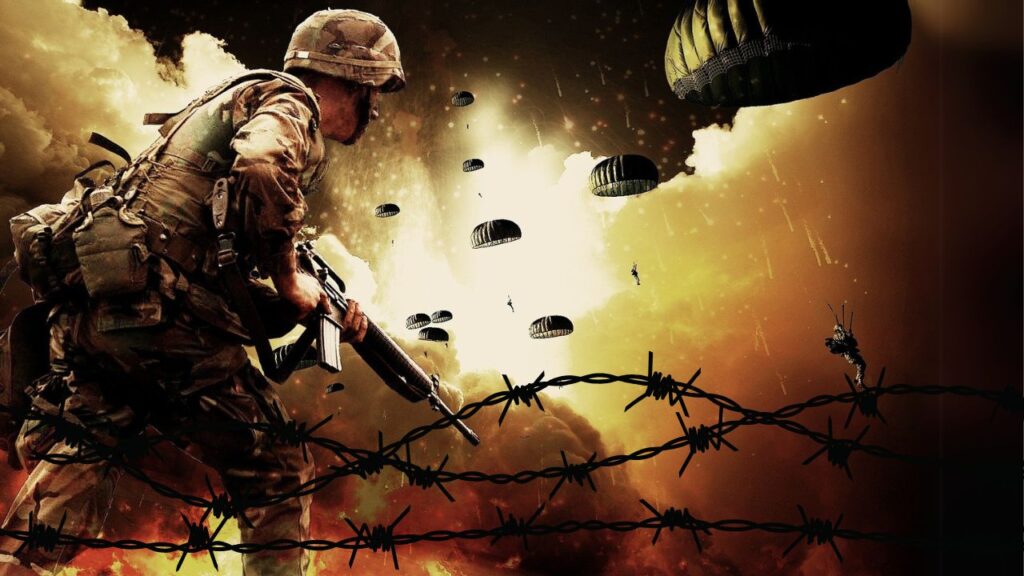Operation Sindoor became a symbol of retaliation and valor against terrorism
On May 7, India responded to the April 22 terrorist attack in Pahalgam with “Operation Sindoor,” making it clear once again that it will neither remain silent nor tolerate terrorist attacks. The attack had claimed the lives of 26 innocent Indian citizens and was clearly orchestrated from terrorist bases in Pakistan. In a precise and strategic military operation, India destroyed nine terrorist camps in Pakistan and Pakistan-occupied Kashmir (PoK) at around 1:30 a.m. on May 7.
This operation was a well-planned, limited, and accurate strike, with a clear objective: to crush terrorism at its very root. The name “Sindoor” (vermilion) reflects India’s cultural and emotional perspective. In Indian tradition, sindoor symbolizes strength, fortune, and honor, and in this context, it also represents the blood of martyrs, whose sacrifice inspired this mission of retribution.

Operation Targeted Terror Infrastructure, Not Civilians
With Operation Sindoor, India made it clear that the strikes were only aimed at terrorist infrastructures responsible for infiltration, suicide attacks, and arms smuggling into India. Bahawalpur is the stronghold of Jaish-e-Mohammed, while Muzaffarabad and Kotli serve as launchpads for Lashkar-e-Taiba and Hizbul Mujahideen.
Through these strikes, India attempted to cripple the backbone of these terror outfits that have long worked to destabilize the country. The operation also reassured Indian citizens that national security is not limited to paperwork—it is being enforced decisively on the ground.
This operation sends a message not just to Pakistan, but also to all hostile forces across the border, that India will now respond in the same language if provoked, and that the sacrifices of its soldiers and civilians will not go in vain.
High-Tech Precision Strikes by the Indian Air Force
The Indian Air Force deployed advanced missiles during the strikes in Bahawalpur, Muzaffarabad, Kotli, Muridke, Bagh, and certain terror-prone areas in Punjab province of Pakistan. This move demonstrated to the world that India no longer needs anyone’s permission to combat terrorism and is fully prepared to take all necessary steps for the protection of its citizens.
The planning and execution of this operation were highly confidential and technologically advanced. Indian intelligence agencies swiftly identified terrorist hideouts after the April 22 attack and coordinated seamlessly with the military—an example of India’s matured national security strategy.
According to the Ministry of Defence, the objective was only to target terror camps, not Pakistani military or civilian installations. A total of 24 missiles were launched, most of which hit terror facilities of Lashkar-e-Taiba and Jaish-e-Mohammed with precision.
Terror Leaders Eliminated, Pakistan in Denial
Reports suggest that several terrorists were killed in the strikes, including top commanders from Lashkar and Jaish who were key planners of attacks on Indian soil.
Pakistan’s local media and administration initially denied the attack, then issued contradictory statements. ISPR (Pakistan Army’s media wing) chief Lt. Gen. Ahmed Sharif claimed India launched missiles at six locations, killing eight civilians. Meanwhile, Pakistan’s Defence Minister Khawaja Asif claimed on Geo TV that India struck from within its own airspace and targeted residential areas.
These inconsistent statements clearly indicate that Pakistan was neither prepared for the strike nor fully aware of its extent. In contrast, India immediately informed the United States of the operation. National Security Advisor Ajit Doval spoke with U.S. NSA and Secretary of State Marco Rubio, clarifying that the action was solely against terrorism—not an attack on Pakistan’s sovereignty.
The Indian Embassy in the U.S. also released a statement confirming that no Pakistani military or civilian sites were targeted, only terrorist camps that were actively plotting attacks against India.
PM Modi Oversaw the Operation Directly
Prime Minister Narendra Modi monitored the entire operation, giving the armed forces complete autonomy while keeping a close eye on the details. After the mission’s success, the Indian Army posted “Justice is served” on social media platform X (formerly Twitter), while Defence Minister Rajnath Singh dedicated the strike to the nation with the slogan “Bharat Mata ki Jai” (Victory to Mother India).
As expected, tensions between India and Pakistan escalated following the strike. Pakistan retaliated with cross-border firing and propaganda, falsely claiming to have shot down six Indian fighter jets, including 3 Rafales, 2 MiG-29s, and 1 Sukhoi, and to have destroyed the headquarters of the Indian Army’s 12th Infantry Brigade. India has categorically rejected all such baseless claims.
The Next Step: Diplomatic and Strategic Follow-Up
India’s next move must be to convert this military action into global diplomatic support. Operation Sindoor strengthens India’s position against terrorism on international platforms. While countries like the U.S., France, Russia, and Israel have shown support, Pakistan will attempt to manipulate the narrative at forums like the United Nations and the Organisation of Islamic Cooperation (OIC).
India must now advance in this diplomatic battle with clarity and facts. Operation Sindoor is not only a testament to India’s military precision, but also its diplomatic maturity. It proves that India is now implementing a defense policy rooted in restraint, accountability, and readiness.
Though sindoor traditionally represents strength and auspiciousness in Indian culture, in this case, it has become a symbol of vengeance and valor against terrorism. India has shown that while it doesn’t seek war or conflict, any threat to its borders, citizens, or sovereignty will be met with a swift, precise, and decisive response.
This changing stance marks a new direction in India’s national security doctrine, and sends a clear warning: no future terrorist act will be ignored—every strike will be answered with force.
On May 7, India responded to the April 22 terrorist attack in Pahalgam with “Operation Sindoor,” making it clear once again that it will neither remain silent nor tolerate terrorist attacks. The attack had claimed the lives of 26 innocent Indian citizens and was clearly orchestrated from terrorist bases in Pakistan. In a precise and strategic military operation, India destroyed nine terrorist camps in Pakistan and Pakistan-occupied Kashmir (PoK) at around 1:30 a.m. on May 7.
This operation was a well-planned, limited, and accurate strike, with a clear objective: to crush terrorism at its very root. The name “Sindoor” (vermilion) reflects India’s cultural and emotional perspective. In Indian tradition, sindoor symbolizes strength, fortune, and honor, and in this context, it also represents the blood of martyrs, whose sacrifice inspired this mission of retribution.
Operation Targeted Terror Infrastructure, Not Civilians
With Operation Sindoor, India made it clear that the strikes were only aimed at terrorist infrastructures responsible for infiltration, suicide attacks, and arms smuggling into India. Bahawalpur is the stronghold of Jaish-e-Mohammed, while Muzaffarabad and Kotli serve as launchpads for Lashkar-e-Taiba and Hizbul Mujahideen.
Through these strikes, India attempted to cripple the backbone of these terror outfits that have long worked to destabilize the country. The operation also reassured Indian citizens that national security is not limited to paperwork—it is being enforced decisively on the ground.
This operation sends a message not just to Pakistan, but also to all hostile forces across the border, that India will now respond in the same language if provoked, and that the sacrifices of its soldiers and civilians will not go in vain.
High-Tech Precision Strikes by the Indian Air Force
The Indian Air Force deployed advanced missiles during the strikes in Bahawalpur, Muzaffarabad, Kotli, Muridke, Bagh, and certain terror-prone areas in Punjab province of Pakistan. This move demonstrated to the world that India no longer needs anyone’s permission to combat terrorism and is fully prepared to take all necessary steps for the protection of its citizens.
The planning and execution of this operation were highly confidential and technologically advanced. Indian intelligence agencies swiftly identified terrorist hideouts after the April 22 attack and coordinated seamlessly with the military—an example of India’s matured national security strategy.
According to the Ministry of Defence, the objective was only to target terror camps, not Pakistani military or civilian installations. A total of 24 missiles were launched, most of which hit terror facilities of Lashkar-e-Taiba and Jaish-e-Mohammed with precision.
Terror Leaders Eliminated, Pakistan in Denial
Reports suggest that several terrorists were killed in the strikes, including top commanders from Lashkar and Jaish who were key planners of attacks on Indian soil.
Pakistan’s local media and administration initially denied the attack, then issued contradictory statements. ISPR (Pakistan Army’s media wing) chief Lt. Gen. Ahmed Sharif claimed India launched missiles at six locations, killing eight civilians. Meanwhile, Pakistan’s Defence Minister Khawaja Asif claimed on Geo TV that India struck from within its own airspace and targeted residential areas.
These inconsistent statements clearly indicate that Pakistan was neither prepared for the strike nor fully aware of its extent. In contrast, India immediately informed the United States of the operation. National Security Advisor Ajit Doval spoke with U.S. NSA and Secretary of State Marco Rubio, clarifying that the action was solely against terrorism—not an attack on Pakistan’s sovereignty.
The Indian Embassy in the U.S. also released a statement confirming that no Pakistani military or civilian sites were targeted, only terrorist camps that were actively plotting attacks against India.
PM Modi Oversaw the Operation Directly
Prime Minister Narendra Modi monitored the entire operation, giving the armed forces complete autonomy while keeping a close eye on the details. After the mission’s success, the Indian Army posted “Justice is served” on social media platform X (formerly Twitter), while Defence Minister Rajnath Singh dedicated the strike to the nation with the slogan “Bharat Mata ki Jai” (Victory to Mother India).
As expected, tensions between India and Pakistan escalated following the strike. Pakistan retaliated with cross-border firing and propaganda, falsely claiming to have shot down six Indian fighter jets, including 3 Rafales, 2 MiG-29s, and 1 Sukhoi, and to have destroyed the headquarters of the Indian Army’s 12th Infantry Brigade. India has categorically rejected all such baseless claims.
The Next Step: Diplomatic and Strategic Follow-Up
India’s next move must be to convert this military action into global diplomatic support. Operation Sindoor strengthens India’s position against terrorism on international platforms. While countries like the U.S., France, Russia, and Israel have shown support, Pakistan will attempt to manipulate the narrative at forums like the United Nations and the Organisation of Islamic Cooperation (OIC).
India must now advance in this diplomatic battle with clarity and facts. Operation Sindoor is not only a testament to India’s military precision, but also its diplomatic maturity. It proves that India is now implementing a defense policy rooted in restraint, accountability, and readiness.
Though sindoor traditionally represents strength and auspiciousness in Indian culture, in this case, it has become a symbol of vengeance and valor against terrorism. India has shown that while it doesn’t seek war or conflict, any threat to its borders, citizens, or sovereignty will be met with a swift, precise, and decisive response.
Stay updated with Latest International News in Hindi on Prabhasakshi

